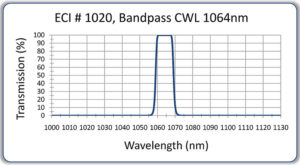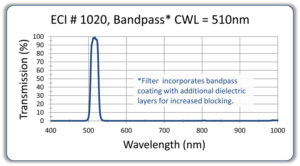Optical Band pass Filters are available for wide sideband blocking applications for maximum performance from 400nm – 2000nm. Typical out-of-band rejection is 0.01% T (OD 4) or better. ECI’s bandpass optical filters have high transmission levels with low passband ripple. Typical peak passband transmission is > 90%. These filters have excellent environmental stability for demanding military and telecommunication applications.
High performance coatings are deposited on custom optics, polymers, fibers, crystals, semiconductors and glass substrates up to 200mm in diameter.
Band pass filters are designed to selectively transmit light over a certain wavelength band while blocking the remaining light in a given spectrum. Most of the filters that ECI produces are designed using Fabry-Perot cavities or by combining Shortwave Pass (SWP) and Long Wave Pass (LWP) filter coatings. A Fabry-Perot cavity is produced by separating reflective quarter wave stacks by a half wave spacer layer.
As Figure 1 shows, increasing the number of cavities will increase the optical density (OD) in the blocking band. Increasing the number of quarter wave pairs in each cavity will also increase the optical density in the blocking band.
Reducing the number of quarter wave pairs in each cavity while increasing the number of cavities will result in a bandpass filter with a wider passband. Fabry-Perot filters are typically used in applications where strict tolerances are required for center wavelength (CW) and bandwidth, which is typically specified as Full-Width at Half Maximum (FWHM). Such applications include fluorescence microscopy, 3D imaging, Gesture Recognition, and Light Detection and Ranging (LIDAR).

Figure 1
For band pass filters that require a wider blocking band, ECI will incorporate quarter wave interference stacks to a Fabry-Perot cavity filter to achieve additional blocking. Figure 2 shows a band pass filter that is designed with additional blocking from 350 to 1100nm. Band pass filters with extended blocking can be useful when dealing with broadband light sources and detectors.

Figure 2
Combining Shortwave pass (SWP) and Longwave Pass (LWP) filter coatings is another approach that ECI uses. This approach is commonly used when a wider passband and/or a wider blocking band is required. This approach will also be used when the tolerances on central wavelength and bandwidth are not very strict.
Example filter by wavelength:
- 365 nm
- 400 nm
- 532 nm
- 515 nm
- 650 nm
- 850 nm
- 940 nm
Both sides of the substrate are typically coated for this type of design, which is imperative when concerned about thin film stress warping the substrate. Wide band pass filters are used in a variety of applications including industrial imaging, photography, and automotive sensor systems.
Figure 3 shows an example of a wide band pass filter that allows visible light to transmit while blocking the near infrared (NIR) and ultraviolet (UV) regions of the spectrum.

Figure 3
Bandpass Filter Applications
Band pass filters can be used for a variety of applications in a wide range of industries that are growing substantially. More recently, lasers have been on the forefront of the newer technology being developed. Laser systems use optical filters to target certain functionalities of the laser, which range from medical technology to geographical information systems and many more applications.
Imaging techniques for retinal imaging is just one of many band pass filter applications for laser technology in the medical industry. Laser technology can be used for a variety of detection methods, which provide physicians with non-destructive and non-invasive ways to better treat their patients. It can also provide structural and functional information about different organs, blood, etc. through fluorescence technology that aids in providing early detection capabilities as well.
Specialized mapping and geographical information systems (GIS) technology are using a specific laser technology known as LiDAR (Light Detection and Ranging). LiDAR is a unique and versatile laser system that actively sends light energy to the ground, allowing for information to be sent back to the sensor regarding surface composition, elevation, etc. LiDAR can also be used for safety features on vehicles, as well as for testing methods for law enforcement officers and traffic safety. Through targeting the transmittance of certain wavelengths, sensors can interpret these readings to analyze speed and proximity to nearby objects.
ECI’s Band pass filters are available for wide sideband blocking applications for maximum performance from 400nm – 2000nm. Typical out-of-band rejection is 0.01% T (OD 4) or better. Our products have high transmission levels with low passband ripple. Typical peak passband transmission is > 90%. These filters have excellent environmental stability for demanding military/defense and telecommunication applications.
High performance coatings can be deposited onto custom optics, crystals, polymers, fibers, semiconductors and glass substrates up to 200mm in diameter.
Designs meet or exceed the environmental requirements of MIL-C-48497.
Targeted Applications:
- Biomedical/medical detection technology
- Ophthalmic detection
- Automotive Safety
- Traffic Control
- Geographical Information Systems
- Environmental Awareness
- Topographic
- Bathymetric
Evaporated Coatings, Inc. can provide both wide and narrow bands in a variety of wavelengths ranging from ultraviolet to near-infrared (200 to 2000 nm). Customized optical band pass filters can be developed by the design team to meet your challenging, unique specifications.
Contact our design team to discuss your specific application!





